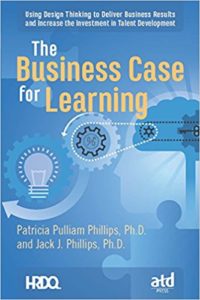 There is a disconnect between what senior executives want from learning and development, and what they actually see. In fact, 96 percent of Fortune 500 CEOs want to see a business connection, yet only 8 percent see it. And 74 percent want to see ROI, yet only 4 percent see it, according to Patti and Jack Phillips of the ROI Institute and authors of The Business Case for Learning: Using Design Thinking to Deliver Business Results and Increase the Investment in Talent Development.
There is a disconnect between what senior executives want from learning and development, and what they actually see. In fact, 96 percent of Fortune 500 CEOs want to see a business connection, yet only 8 percent see it. And 74 percent want to see ROI, yet only 4 percent see it, according to Patti and Jack Phillips of the ROI Institute and authors of The Business Case for Learning: Using Design Thinking to Deliver Business Results and Increase the Investment in Talent Development.
To many, training dollars are wasted on employees who don’t apply the lessons they learn on the job.
“One of the biggest dilemmas—and it’s directly related to the lack of ROI we just discussed—is that senior executives tend to see learning and development as a cost, rather than an investment,” notes Patti. “Thus, in times of economic anxiety, this is the first budget to cut—when, really, it should be enhanced.”
So, as a new leader, how do you ensure that the training you provide improves employee performance to the point that the top brass see it as an essential investment for the business? The authors have put together an eight-step process that they outline in the book. Here is some key insight that you can use, regardless your level within the company or training budget.
Align training with business goals
We’ve heard “start with the end in mind” many times, but the end is not simply having great programs that participants see as valuable. The end is how the training will positively impact the business, and how it meets a business need. Whether the payoff need is to bump up growth, improve safety records, boost inadequate customer service, prepare new supervisors to lead, or something else, it needs to be expressed as a specific measure.
Select the right solution
With the business need clearly defined, the next step is to decide on the solution. Don’t just pick training because it seems cool or because “everyone else is doing it.” You need to find the right training, both in topic and format, that works for your employees. What should employees do (or stop doing) that will have the desired business outcome? Do some investigating, ask questions and conduct an analysis, to understand in what areas your employees need to improve. Then find training that matches those needs.
Ensure that it matters to attendees
The key to making it matter is to develop a program with content that is relevant, meaningful, important to the individuals and the organization, action-oriented, and something that they will use. That requires prospective participants to decide if a program is right for them, and making sure that they are attending at the right time and the right place, with the proper support.
Make it stick
The reality is that if a person does not use what they’ve learned, the training is a failure. Unfortunately, research continues to show that much of what is learned in formal talent development programs is not used on the job. So it will be up to you to make sure that they understand why the training is important and then hold them accountable for using it.
“There really are some very simple things a company can do that have a big impact,” says Patti. For example, take just 30-60 seconds to discuss what team members will learn and set learning expectations prior to the training. Then have another brief discussion after the training to talk about what they learned and how they can apply it to their work. “Making it stick is not as difficult as it seems,” she adds.
Jack J. Phillips, PhD, and Patti Phillips, PhD, are coauthors of The Business Case for Learning: Using Design Thinking to Deliver Business Results and Increase the Investment in Talent Development. Jack is the chairman of ROI Institute, the leading provider of services for measurement, evaluation, metrics and analytics. He has authored or edited more than 100 books.
Patti is president & CEO of ROI Institute. Her clients include Fortune 500 companies, federal and state government agencies and non-governmental organizations. She serves as faculty for the UN System Staff College in Turin, Italy. Patti is author, coauthor or editor of over 75 books and dozens of articles on the topic of measurement, evaluation and ROI.

0 comments